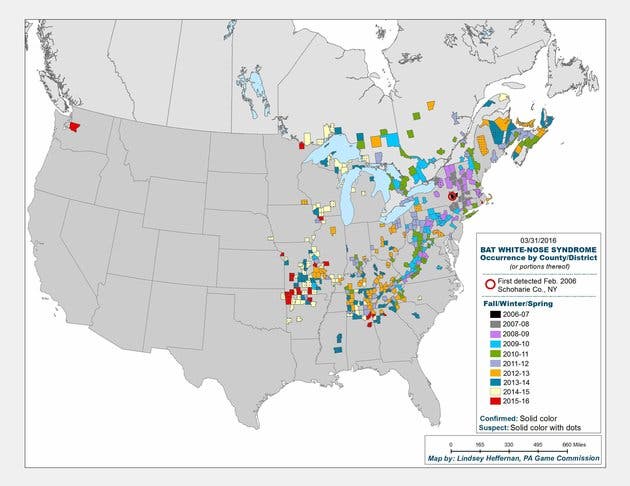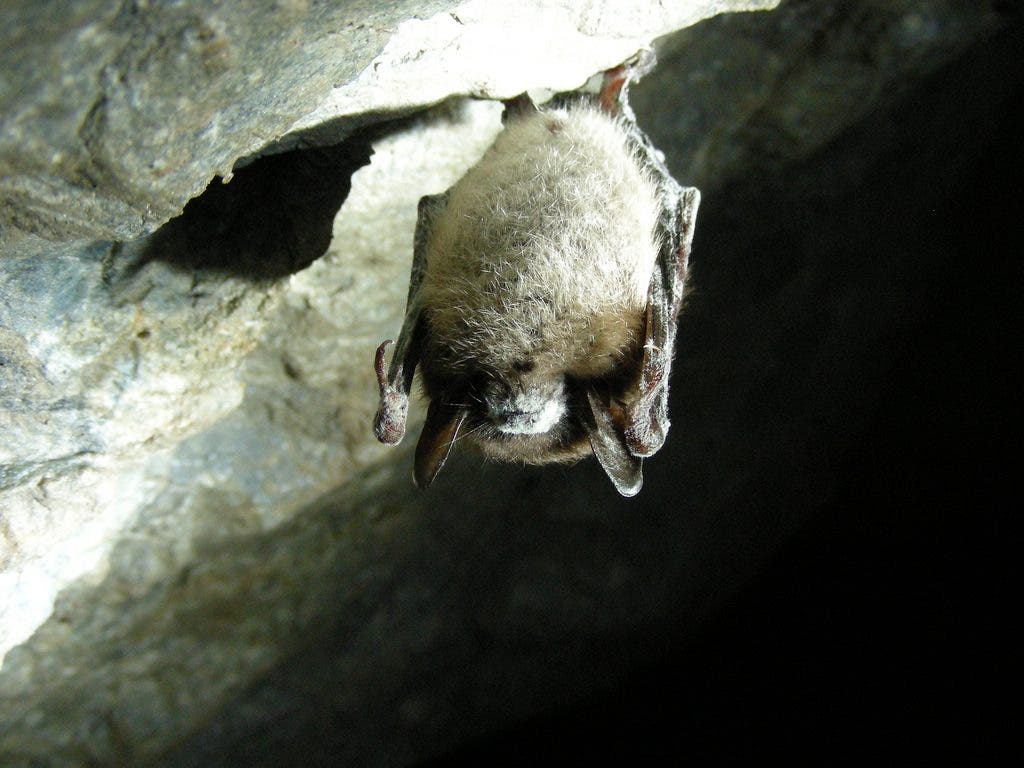The first case of white nose syndrome, a disease that has wreaked havoc on bat populations in the eastern U.S. has been identified west of the Rockies. The disease’s spread threatens to drastically impact bat populations there, altering ecosystems throughout the country.
Hikers discovered a little brown bat with white nose syndrome on a trail east of Seattle last in mid-March this year, the Department of Fish and Wildlife and the U.S. Geological Survey announced on Tuesday. This marks the first incidence of the deadly fungus west of the Rockies. The ailing bat was taken to an animal shelter, where it died two days later.

Image credits to U.S. Fish and Wildlife Service Headquarters.
USGS National Wildlife Health Center’s Wildlife Disease Diagnostic Laboratories branch chief David Blehert thinks it’s “surprising and unusual” to find the fungus spread this far west — the closest the syndrome has been identified before was Nebraska, some 1,300 miles from the site.
“We’ve been dreading this,” said senior scientist at the Center for Biological Diversity Mollie Matteson in an interview for The Huffington Post. “This is a drastic jump.”
“This is the first time, to our knowledge, that there has been a long-range jump of the fungus,” Blehert said.
Caused by the fungus Pseudogymnoascus destructan, white nose syndrome can wipe out entire bat colonies. It gets its name from the white fuzzy fungal growths on the noses, wings and ears of affected bats. The devastating disease spreads throughout bodily tissue, disrupting physiological processes and interrupting essential hibernation periods, causing bats to waste away.
It has already caused the deaths of more than 6 million bats in the eastern U.S, in what some describe as the steepest decline or North American wildlife of the past century.
Seven different species of cave hibernating bats in 28 U.S. states and five Canadian provinces have been affected by white nose syndrome since 2006, when the first case was recorded in upstate New York. Two of these species are native to Washington state.
“I wish I could be optimistic, but given what we have seen on the East Coast, it’s hard to,” said Sharlene E. Santana, assistant professor of biology at the University of Washington.
“We knew it was coming [to the West], but we didn’t know it would be so soon,” Matteson said.

Image credits Washington Department of FIsh and Wildlife.
Blehert’s analysis of the Washington bat revealed that the disease was at an advanced stage, suggesting it had been present in the area for quite some time. Genetic sequencing indicates that the animal is a native to the area.
“We don’t know how the fungus got there,” Blehert said.
The fungus could have been transported bat-to-bat — which would have taken an extraordinarily long time. Or, as Blehert suspects, through human travel and trade, one of the largest spreader of infectious diseases. Humans aren’t affected by the fungus but act as carriers and are believed to (unknowingly) play a central part in transporting the disease across the country. Hikers’ and spelunkers’ clothes and gear can transport the fungus, according to the researchers.

Image credits Marvin Moriarty/USFWS, via flirk.
Unfortunately there is no proven method to cure the disease or at least halt its spread.
“We had hope that by the time [white nose syndrome] started to spread to the West, that there were more effective treatments in place,” Matteson said.
Scientists are now looking into the genetic code of the fungus to determine its point of origin and try to set up precautions to halt its spread around the world — the fungus most likely arrived in the U.S. on a human carrier from Asia or Europe where it’s endemic. They’re also looking into creating a vaccine that could give the bats a fighting chance against white nose syndrome.
“For years, we have been saying there needs to be stricter protocol put in place to minimize the chance of a jump like this via human transmission,” Matterson added.
Authorities are now putting abandoned mines and caves under lock-down to protect resident bat colonies. Federal agencies encourage visitors to decontaminate themselves and gear before entering an area with bats, but Matteson argued decontamination should be mandatory.
“We have species that are at risk of going extinct; it’s the least that could be done.”
Bats are an integral part of an ecosystem, and scientists are concerned about the chain reaction their loss might have on plant and animal life, including humans. If the bat population declines, insects would thrive and devastate agricultural areas. Populations of disease-carrying insects would also be left unchecked.
However, there might still be hope. Because bats in the western U.S. tend not to hibernate in large groups, the disease might not spread as widely or quickly from bat to bat. But far less is known in general about how bats hibernate on the West Coast, Matterson said, which means the bats could already be dying.
“As the case in Washington indicates, the disease has already been there for a couple years, and it just got discovered this past month,” she added.
“One of the huge problems with white nose syndrome has been that the [government] response was slow to get off the ground, it was disorganized, a lack of leadership, there wasn’t any decontamination requirement for western public lands, no cave closures.”
“There will be more in the future,” she concluded. “We need to learn our lesson.”
Wildlife officials encourage people who encounter sick or dead bats to report it via an online reporting tool or telephone hotline, 1-800-606-8768.






